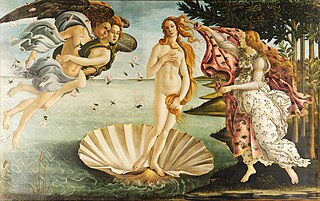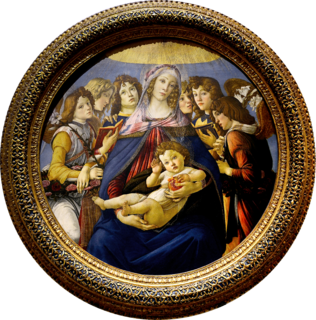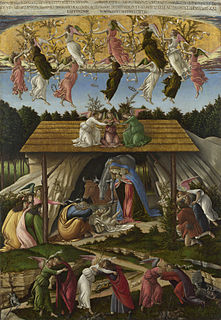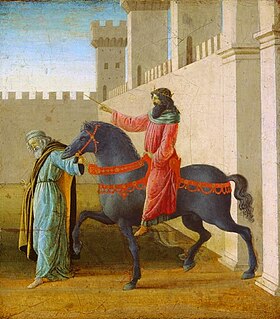
Alessandro di Mariano di Vanni Filipepi, known as Sandro Botticelli, was an Italian painter of the Early Renaissance. Botticelli's posthumous reputation suffered until the late 19th century, when he was rediscovered by the Pre-Raphaelites who stimulated a reappraisal of his work. Since then, his paintings have been seen to represent the linear grace of Early Renaissance painting.

The Birth of Venus is a painting by the Italian artist Sandro Botticelli, probably made in the mid 1480s. It depicts the goddess Venus arriving at the shore after her birth, when she had emerged from the sea fully-grown. The painting is in the Uffizi Gallery in Florence, Italy.

Filippino Lippi was an Italian painter working in Florence, Italy during the later years of the Early Renaissance and first few years of the High Renaissance.

A panel painting is a painting made on a flat panel made of wood, either a single piece, or a number of pieces joined together. Until canvas became the more popular support medium in the 16th century, it was the normal form of support for a painting not on a wall (fresco) or vellum, which was used for miniatures in illuminated manuscripts and paintings for the framing.

Pallas and the Centaur is a painting by the Italian Renaissance painter Sandro Botticelli, c. 1482. It is now in the Uffizi Gallery in Florence. It has been proposed as a companion piece to his Primavera, though it is a different shape. The medium used is tempera paints on canvas and its size is 207 x 148 cm. The painting has been retouched in many places, and these retouchings have faded.

The Madonna of the Pomegranate was painted in circa 1487 with tempera on a wood panel by Sandro Botticelli. Sandro Botticelli is a well known Italian Renaissance artist from Florence, Italy. The use of the circular format, better known as a tondo, focuses the attention on the main characters, the Virgin Mary and baby Jesus, who are surrounded symmetrically by angels on each side. Botticelli's use of tempera grassa give the characters a real look, better known as a "naturalistic" style, which is common during the Renaissance. The Virgin Mary is holding baby Jesus gently in her arms while holding a pomegranate in her left hand. The pomegranate being displayed has a few different interpretations of its meaning in the religious piece. There are many replicas of the Madonna of the Pomegranate due to artists during the Renaissance would copy other established artists' artwork to master their own skills. The painting is currently on display at the Uffizi Gallery in Florence, Italy.

The Madonna of the Book, or the Madonna del Libro, is a small painting by the Italian Renaissance artist Sandro Botticelli, and is preserved in the Poldi Pezzoli Museum in Milan. The painting is executed in tempera on panel. It dates from between 1480 and 1481.

A tondo is a Renaissance term for a circular work of art, either a painting or a sculpture. The word derives from the Italian rotondo, "round." The term is usually not used in English for small round paintings, but only those over about 60 cm in diameter, thus excluding many round portrait miniatures – for sculpture the threshold is rather lower.

The Mystical Nativity is a painting dated c. 1500–1501 by the Italian Renaissance master Sandro Botticelli, in the National Gallery in London. Botticelli built up the image using oil on canvas. It is his only signed work and has an unusual iconography for a painting of the Nativity.

The Fortitude is a painting by the Italian Renaissance master Sandro Botticelli, finished in 1470. Housed in the Galleria degli Uffizi, in Florence, Italy, Fortitude was the first recorded masterpiece by Botticelli.

The Portrait of Smeralda Brandini is a tempera on panel painting by the Italian Renaissance artist Sandro Botticelli of about 1475, in the Victoria and Albert Museum, London.

The Virgin and Child with the Infant Saint John the Baptist is a tempera painting on wood executed by the Italian Renaissance master Sandro Botticelli and his studio. The tondo, painted in Florence between the years of 1490 and 1500, addresses a central theme of the Italian Renaissance art: the divine motherhood. The work is now in the São Paulo Museum of Art.

Venus and Mars is a panel painting of about 1485 by the Italian Renaissance painter Sandro Botticelli. It shows the Roman gods Venus, goddess of love, and Mars, god of war, in an allegory of beauty and valour. The youthful and voluptuous couple recline in a forest setting, surrounded by playful baby satyrs.

The Calumny of Apelles is a panel painting in tempera by the Italian Renaissance painter Sandro Botticelli. Based on the description of an ancient lost painting by Apelles, the work was completed in about 1494–95, and is now in the Uffizi, Florence.

Primavera, is a large panel painting in tempera paint by the Italian Renaissance painter Sandro Botticelli made in the late 1470s or early 1480s. It has been described as "one of the most written about, and most controversial paintings in the world", and also "one of the most popular paintings in Western art".

Venus and the Three Graces Presenting Gifts to a Young Woman, also known as Giovanna degli Albizzi Receiving a Gift of Flowers from Venus, is a fresco painting by the Italian Renaissance painter Sandro Botticelli of circa 1483–1486. The painting and its companion piece, A Young Man Being Introduced to the Seven Liberal Arts, originally decorated the walls of Villa Lemmi, a country villa near Florence owned by Giovanni Tornabuoni, uncle of Lorenzo de' Medici and head of the Roman branch of the Medici Bank. They were probably commissioned for the wedding in 1486 of Giovanni's son Lorenzo to Giovanna of the Albizzi family, and are therefore thought to depict the two.

Pastiglia[paˈstiʎʎa], an Italian term meaning "pastework", is low relief decoration, normally modelled in gesso or white lead, applied to build up a surface that may then be gilded or painted, or left plain. The technique was used in a variety of ways in Italy during the Renaissance. The term is mostly found in English applied to gilded work on picture frames or small pieces of furniture such as wooden caskets and cassoni, and also on areas of panel paintings, but there is some divergence as to the meaning of the term between these specialisms.

The Divine Comedy Illustrated by Botticelli is a manuscript of the Divine Comedy by Dante, illustrated by 92 full-page pictures by Sandro Botticelli that are considered masterpieces and amongst the best works of the Renaissance painter. The images are mostly not taken beyond silverpoint drawings, many worked over in ink, but four pages are fully coloured. The manuscript eventually disappeared and most of it was rediscovered in the late nineteenth century, having been detected in the collection of the Duke of Hamilton by Gustav Friedrich Waagen, with a few other pages being found in the Vatican Library. Botticelli had earlier produced drawings, now lost, to be turned into engravings for a printed edition, although only the first nineteen of the hundred cantos were illustrated.

Scenes from the Life of Saint Zenobius is a series of paintings by the Italian Renaissance artist Sandro Botticelli. Four panels from the series survive, which are now in three different museums. Each depicts three or more incidents from the life of Zenobius, an early Bishop of Florence who perhaps died in 417. The works are all in tempera on wood, and around 66 cm (26 in) high, though their length varies rather more, from about 149 to 182 cm.

Life of Esther or Scenes from the Story of Esther is the title of a series of six panel paintings by Sandro Botticelli and Filippino Lippi, showing scenes from the story of Esther and produced in the 1470s. They originally decorated the sides of a pair of cassoni or marriage chests, the two long panels on the fronts, and the smaller ones on the ends. They are now split between five museums in Europe and Canada.




















